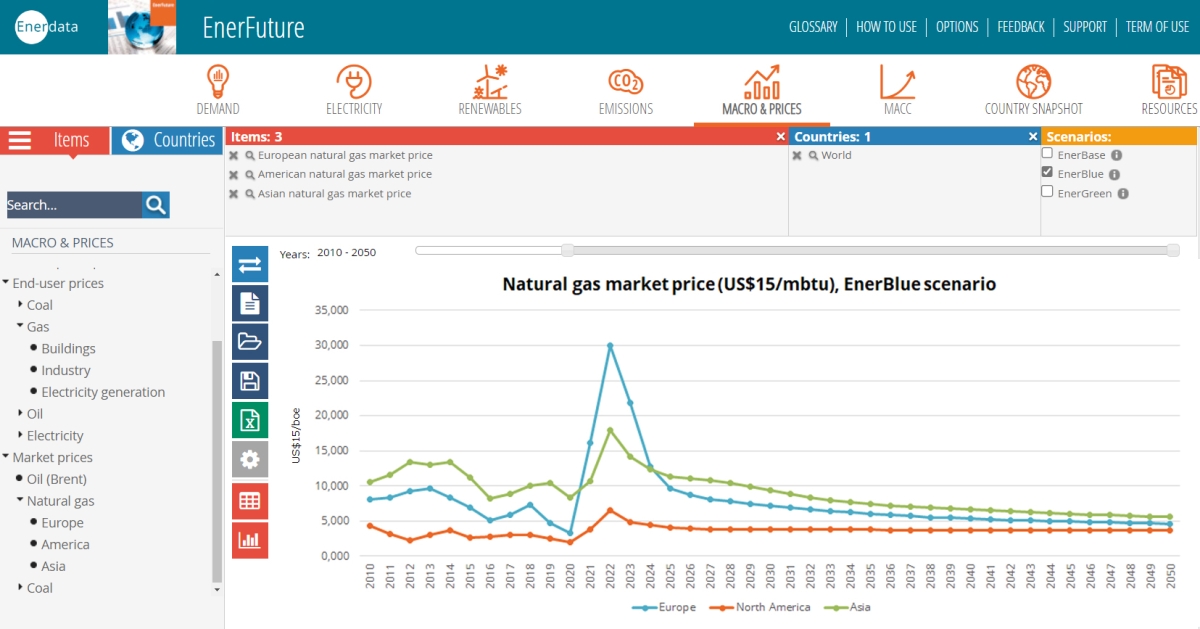EnerFuture, our service providing long-term energy projections (by energy source, country and sector) at global and country levels, has just been updated. New developments have enhanced the coverage of our projections, refined some of our techno-economic approaches, and included the major impacts of recent game changers (Covid-19, Ukrainian crisis, new NDCs) in all three scenarios:
- EnerBase remains the business-as-usual scenario, illustrating the effects of current policies and trends
- EnerBlue has evolved to reflect the successful achievement of the latest NDCs (COP 26), setting higher emissions reduction targets than the previous Paris Agreement
- EnerGreen explores the consequences of more stringent climate policies, leading to a global temperature increase limited under 2°C by 2050.
In addition to these newly adapted scenario definitions, we have remained committed to continually improving our methods, for ever-more insightful projections. This entails:
- A novel approach to scenario construction, which better accounts for the role of demand-side drivers in decarbonisation
- The introduction of a refined techno-economic approach to the different energy uses in the buildings sector
- Enhanced coverage of the iron and steel sector
- A detailed integrated assessment of natural gas decarbonisation potential through biogas and hydrogen
Forecasts up to 2050 with EnerFuture
March 9, 2020
Our EnerFuture service, which provides you with unbiased energy forecasts and country benchmarks, has just been updated. We offer a notable enhancement this year, as starting now, the projections go up to 2050 (and not 2040 any more) for the three Enerdata scenarios:
- EnerBase, the business-as-usual scenario,
- EnerBlue, the Paris-agreement-compatible scenario, and
- EnerGreen, the scenario exploring how to contain global warming under 2°C.
This will allow a better understanding of the long-term implications of different climate objectives on the global energy system.
Other significant changes include:
- the addition of Saudi Arabia to our country list to extend our Middle East coverage,
- the development of a new feature, a series of indicators on the degree of electrification of the final energy demand (total and by sector: industry, buildings and transportation),
- updated data from the latest statistics,
- and an optimised online interface.
EnerFuture Updated with New Data, Scenarios and Features
March 20, 2019
We’ve just launched the 2019 version of EnerFuture, our service that provides global energy scenarios and trajectories through 2040. This new version contains both a full data update and some useful interface changes, plus updates to the scenarios in our robust forecasting models.
Our most important new content change is a brand-new scenario – EnerBase – which has replaced EnerBrown. Our analysts crafted EnerBase to illustrate the effects of existing policies and trends leading to very limited emissions reduction.
We think this new methodology is more adapted to the current global outlook because it offers a good representation of what a laissez-faire approach to climate change mitigation would imply. This is especially useful to compare with our EnerBlue and EnerGreen scenarios, which show the results of achieving specific climate goals.
Meanwhile, our EnerGreen scenario now includes country- and region-specific trajectories. These trajectories incorporate effort-sharing regulations based on a new, proven methodology.
The changes to our online interface allow users to easily make custom pie charts, line graphs and bar graphs directly in the online service and then download them.
 Energy and Climate Databases
Energy and Climate Databases Market Analysis
Market Analysis



